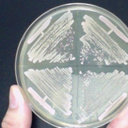A soluble form of fibroblast growth factor receptor 2 (FGFR2) with S252W mutation acts as an efficient inhibitor for the enhanced osteoblastic differentiation caused by FGFR2 activation in Apert syndrome.
کلید واژه ها
خلاصه
Apert syndrome is an autosomal dominant disease characterized by craniosynostosis and bony syndactyly associated with point mutations (S252W and P253R) in the fibroblast growth factor receptor (FGFR) 2 that cause FGFR2 activation. Here we investigated the role of the S252W mutation of FGFR2 on osteoblastic differentiation. Osteoblastic cells derived from digital bone in two Apert patients with the S252W mutation showed more prominent alkaline phosphatase activity, osteocalcin and osteopontin mRNA expression, and mineralized nodule formation compared with the control osteoblastic cells derived from two independent non-syndromic polydactyly patients. Stable clones of the human MG63 osteosarcoma cells (MG63-Ap and MG63-IIIc) overexpressing a splice variant form of FGFR2 with or without the S252W mutation (FGFR2IIIcS252W and FGFR2IIIc) showed a higher RUNX2 mRNA expression than parental MG63 cells. Furthermore MG63-Ap exhibited a higher osteopontin mRNA expression than did MG63-IIIc. The enhanced osteoblastic marker gene expression and mineralized nodule formation of the MG63-Ap was inhibited by the conditioned medium from the COS-1 cells overexpressing the soluble FGFR2IIIcS252W. Furthermore the FGF2-induced osteogenic response in the mouse calvarial organ culture system was blocked by the soluble FGFR2IIIcS252W. These results show that the S252W mutation in the FGFR2 gene enhances the osteoblast phenotype in human osteoblasts and that a soluble FGFR2 with the S252W mutation controls osteoblast differentiation induced by the S252W mutation through a dominant negative effect on FGFR2 signaling in Apert syndrome.



